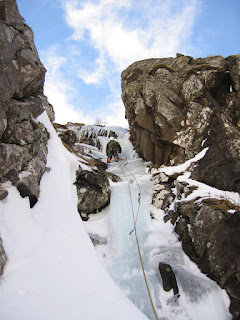As the Days Lengthen...
Not Scotland... Punta Grande Patagonia
An old woman in Ullapool stopped me in the street over New Year and said 'As the days lengthen, the cold strengthens...' and she shook me by the elbow like it was some portent of doom. But she is quite right and the old saying rings true in Scotland... as the days stretch imperceptibly in January we tend to get a cold moist period with high level snows, it seems the hills will be freeze- thawing this month, quite nicely thankyou very much. So in between sessions at the local wall trying to get some fitness for the year, I've dug out my old battered Quasar axes and will be sharpening them with anticipation of days like these photos.
Salamander Gully

Crest Route, Glencoe

I've always felt that winter days can provide the rarest quality mountain experience in all the climbing disciplines. They are usually the most memorable because your senses are sharpened by proximate mortality, freezing your ass on belays, torture-rack hotaches, smashing your nose in with the adze or some such lesson of the snows...
The odds of a perfect blue day that you recall so inaccurately are generally the romantic distillate of abandoned days, poor conditions, getting lost in blizzards, forgetting your harness, scraping off onto a Grade 3, abbing from a shoogly peg because there's 'nae gear'...there's never enough gear in winter, it's all a con(fidence) game!
Beinn an Dothaidh Ice

So why the hell do we do it? Simply because it's a challenge, it shakes us out of the lazy lethargy and comfortable numbness of city life and mod-cons. Nothing like getting up at 4am because you're too gripped and cold for another hour's kip, then walking in through sleet in the vain hope the blizzard will clear to blue skies and perfect chewy ice...
just sometimes though...



